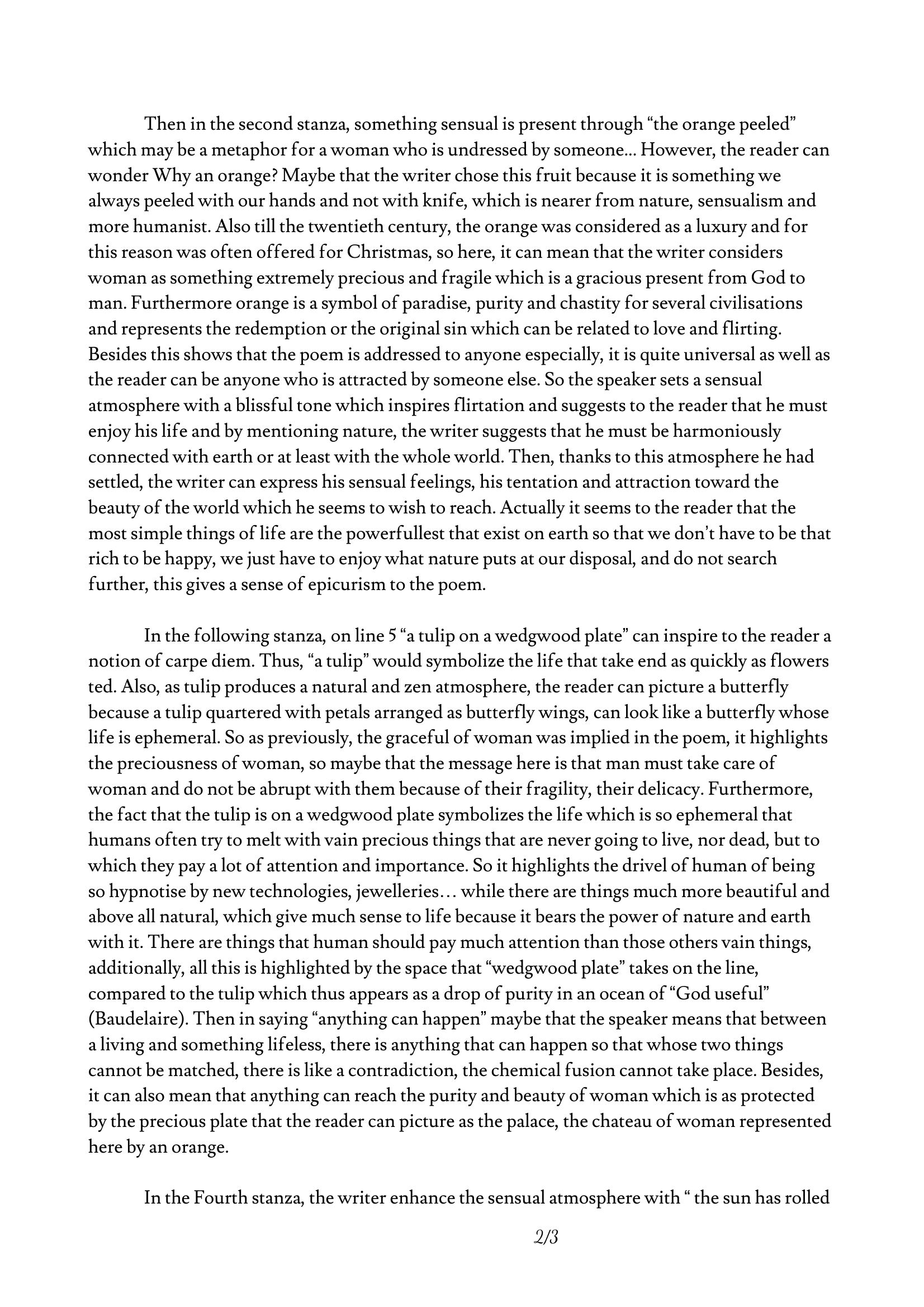Flirtation Analysis
Publié le 09/02/2015

Extrait du document
«
T hen in the second stanza, som ething sensual is present through “the orange peeled”
w hich m ay be a m etaphor for a w om an w ho is undressed by som eone...
H ow ever, the reader can
w onder W hy an orange? M aybe that the w riter chose this fruit because it is som ething w e
alw ays peeled w ith our hands and not w ith knife, w hich is nearer from nature, sensualism and
m ore hum anist.
A lso till the tw entieth century, the orange w as considered as a luxury and for
this reason w as often offered for C hristm as, so here, it can m ean that the w riter considers
w om an as som ething extrem ely precious and fragile w hich is a gracious present from G od to
m an.
Furtherm ore orange is a sym bol of paradise, purity and chastity for several civilisations
and represents the redem ption or the original sin w hich can be related to love and flirting.
Besides this show s that the poem is addressed to anyone especially, it is quite universal as w ell as
the reader can be anyone w ho is attracted by som eone else.
So the speaker sets a sensual
atm osphere w ith a blissful tone w hich inspires flirtation and suggests to the reader that he m ust
enjoy his life and by m entioning nature, the w riter suggests that he m ust be harm oniously
connected w ith earth or at least w ith the w hole w orld.
T hen, thanks to this atm osphere he had
settled, the w riter can express his sensual feelings, his tentation and attraction tow ard the
beauty of the w orld w hich he seem s to w ish to reach.
A ctually it seem s to the reader that the
m ost sim ple things of life are the pow erfullest that exist on earth so that w e don’t have to be that
rich to be happy, w e just have to enjoy w hat nature puts at our disposal, and do not search
further, this gives a sense of epicurism to the poem .
In the follow ing stanza, on line 5 “a tulip on a w edgw ood plate” can inspire to the reader a
notion of carpe diem .
T hus, “a tulip” w ould sym bolize the life that take end as quickly as flow ers
ted.
A lso, as tulip produces a natural and zen atm osphere, the reader can picture a butterfly
because a tulip quartered w ith petals arranged as butterfly w ings, can look like a butterfly w hose
life is ephem eral.
So as previously, the graceful of w om an w as im plied in the poem , it highlights
the preciousness of w om an, so m aybe that the m essage here is that m an m ust take care of
w om an and do not be abrupt w ith them because of their fragility, their delicacy.
Furtherm ore,
the fact that the tulip is on a w edgw ood plate sym bolizes the life w hich is so ephem eral that
hum ans often try to m elt w ith vain precious things that are never going to live, nor dead, but to
w hich they pay a lot of attention and im portance.
So it highlights the drivel of hum an of being
so hypnotise by new technologies, jew elleries… w hile there are things m uch m ore beautiful and
above all natural, w hich give m uch sense to life because it bears the pow er of nature and earth
w ith it.
T here are things that hum an should pay m uch attention than those others vain things,
additionally, all this is highlighted by the space that “w edgw ood plate” takes on the line,
com pared to the tulip w hich thus appears as a drop of purity in an ocean of “G od useful”
(Baudelaire).
T hen in saying “anything can happen” m aybe that the speaker m eans that betw een
a living and som ething lifeless, there is anything that can happen so that w hose tw o things
cannot be m atched, there is like a contradiction, the chem ical fusion cannot take place.
Besides,
it can also m ean that anything can reach the purity and beauty of w om an w hich is as protected
by the precious plate that the reader can picture as the palace, the chateau of w om an represented
here by an orange.
In the Fourth stanza, the w riter enhance the sensual atm osphere w ith “ the sun has rolled
2/3.
»
↓↓↓ APERÇU DU DOCUMENT ↓↓↓
Liens utiles
- Slumdog Millionaire analysis/english/India
- PRÉSENTATION ARTICLE an extract from : un extrait de an analysis :
- Literary Criticism I INTRODUCTION Literary Criticism, discussion of literature, including description, analysis, interpretation, and evaluation of literary works.
- Statistics I INTRODUCTION Statistics, branch of mathematics that deals with the collection, organization, and analysis of numerical data and with such problems as experiment design and decision making.
- Game Theory I INTRODUCTION Game Theory, mathematical analysis of any situation involving a conflict of interest, with the intent of indicating the optimal choices that, under given conditions, will lead to a desired outcome.










